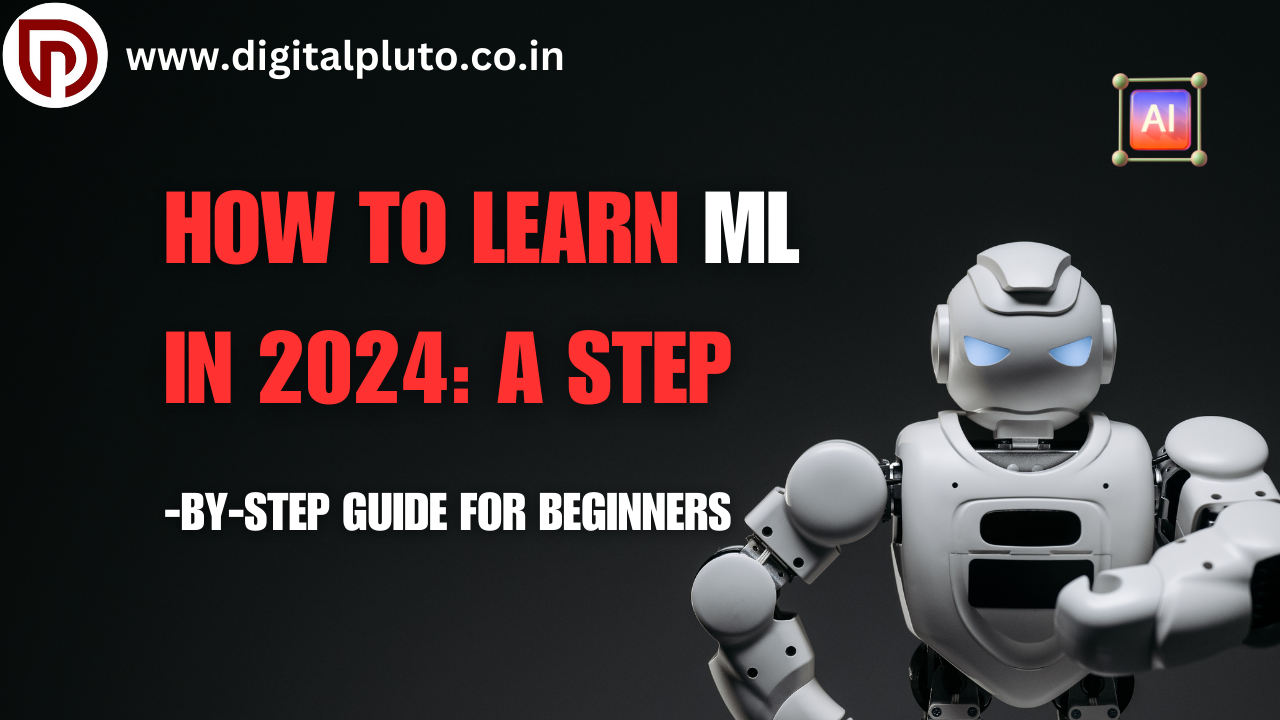
How to Learn ML in 2024

Step 1: Master the Basics of Python

The first and most crucial step is to learn the fundamentals of Python. Python is the programming language used by virtually everyone working in machine learning, and it serves as the foundation for every other step on this list. This advice is especially important for beginners who may not know the basics, like working with lists, dictionaries, if-else statements, and for loops.
I would advise starting with Python classes and tutorials on Google or YouTube. To get you started, a plethora of excellent, free stuff is accessible. Instead of just watching the tutorials passively, it is important to actively code along with them. As you start your machine learning adventure, this will provide you with an enjoyable and interactive experience of how to learn ML in 2024.
Step 2: Develop a Solid Understanding of Mathematics

You will still need a solid understanding of the foundational ideas of calculus, linear algebra, and probability theory even if sophisticated Python modules abstract away a large portion of the intricate mathematics underlying machine learning. Awareness of the underlying workings of the majority of machine learning techniques requires an awareness of these mathematical underpinnings.
Fortunately, success in machine learning does not need a mastery of mathematics. Usually, high school or beginning college-level arithmetic is necessary. All you have to do is comprehend ideas like probability distributions, matrices, and derivatives.
There are many excellent free resources available to learn the necessary math, such as the courses on probability, linear algebra, and matrix algebra. You can also explore platforms like Brilliant.org or take the mandatory math classes required for engineering majors in college.
Step 3: Familiarize Yourself with the ML Developer Stack

It is time to explore the machine learning developer stack now that you have a firm grasp of Python and the required math. This covers programs and libraries such as Matplotlib, NumPy, Pandas, and Jupyter Notebooks.
- Jupyter Notebooks: A web-based interactive computing environment that allows you to combine code, visualizations, and narrative text in a single document. This is a popular tool for machine learning experimentation and prototyping.
- Pandas: A powerful data manipulation and analysis library that makes it easy to work with tabular data, which is common in many machine learning problems.
- NumPy: A library for scientific computing that provides support for large, multi-dimensional arrays and matrices, as well as a large collection of high-level mathematical functions to operate on these arrays.
- Matplotlib: A plotting library for creating static, animated, and interactive visualizations in Python. Visualizing data and the results of your machine learning models is crucial for understanding and communicating your work.
By familiarizing yourself with these core tools and libraries, you’ll not only improve your practical Python skills but also gain valuable experience working with the types of data and tools commonly used in machine learning projects.
Step 4: Learn the Fundamentals of Machine Learning and Deep Learning
Now that the fundamentals have been established, it is time to explore machine learning and deep learning. The most well-known and effective resource for this is Andrew Ng’s Machine Learning Specialization on Coursera.
A broad range of traditional machine learning principles are covered in this course, including support vector machines, neural networks, logistic regression, and linear regression. Additionally, you will gain practical expertise with well-known machine learning frameworks like TensorFlow and scikit-learn.
After completing the Machine Learning Specialization, I would highly recommend watching Andre Karpathy’s Neural Networks series. In this series, Karpathy implements a simple natural language processing (NLP) model from scratch and walks through the mathematics of backpropagation. This is an invaluable resource for truly understanding the inner workings of neural networks.
Step 5: Dive into Advanced Machine Learning and Deep Learning
Now that you have a firm grasp of the fundamentals of deep learning and machine learning, it is time to advance your knowledge. A great next step is Coursera’s Deep Learning Specialization.
Convolutional networks, recurrent networks, and sequence-to-sequence models are among the subjects covered in this course series, which focuses on the useful applications of putting neural networks into practice and training them. Crucially, it also covers the Hugging Face collection, which has emerged as a vital resource in the field of natural language processing (NLP).A broad range of traditional machine learning principles are covered in this course, including support vector machines, neural networks, logistic regression, and linear regression. Additionally, you will gain practical expertise with well-known machine learning frameworks like TensorFlow and scikit-learn.
If you’re particularly interested in NLP, you can also check out the Hugging Face NLP course for an even deeper dive into the latest advancements in this field.
Step 6: Get Your Hands Dirty with Real-World Projects
By this point, you’ve laid a solid foundation in the theory and fundamentals of how to learn ML in 2024. Now it’s time to put your skills to the test by working on real-world projects.
I would suggest starting with Kaggle, a website that offers a large selection of machine learning datasets and challenges. Kaggle is an excellent platform for developing a portfolio of ideas and gaining real-world experience. To gain confidence, begin with easier tasks and work your way up to increasingly difficult contests.
Reusing research articles is another worthwhile project type. This entails reading a published machine learning study, comprehending the suggested methodology, and then putting it into practice from the ground up. You will gain a deeper understanding of the most recent developments in the industry through this difficult yet immensely rewarding exercise. When applying for machine learning jobs, it is also a fantastic method to make an impression.
Finally, don’t forget to explore other ways to showcase your skills and stand out in the job market. You can check out additional tips in my Substack newsletter.
Conclusion
This blog of how to learn ML in 2024, Although it could seem overwhelming, you can position yourself for success by adhering to these six essential steps. Learn the fundamentals of Python and mathematics first, then the machine learning developer stack, machine learning, and deep learning, before moving on to more complex subjects and practical projects.
Keep in mind that there is always more to discover and that the process of studying machine learning is ongoing. You will, however, be well on your way to becoming a skilled machine learning practitioner with the knowledge and abilities to meet the challenges of the future if you adhere to this roadmap.
Follow https://www.digitalpluto.co.in/ for more latest updates about artificial intelligence.






